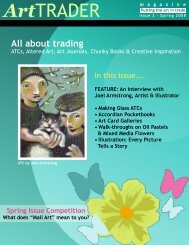Beginner's - ArtTrader Magazine
Beginner's - ArtTrader Magazine
Beginner's - ArtTrader Magazine
You also want an ePaper? Increase the reach of your titles
YUMPU automatically turns print PDFs into web optimized ePapers that Google loves.
Art TRADER<br />
m a g a z i n e<br />
An architectural salvage yard is an absolute treasure to any<br />
community that has one—I frequented one when I lived in<br />
Pittsburgh, and there are two near my new home. With an open<br />
mind and a few dollars, I can leave with a box of rusted switch<br />
plates, hinges and knobs, assorted gauges and electrical boxes<br />
perfect for use in larger altered art projects. The “Create” sign<br />
that hangs on my studio wall is mounted on a piece of board that<br />
was bought for fifty cents at the Roseburg salvage store. It also<br />
incorporates several old fuses that I bought in the same place.<br />
One of the best features of my salvaged countertop is that I<br />
have the space to do “prep work” for my collages. I like using<br />
transparencies that have been colored with alcohol inks to add<br />
a final overlay to my work, and I’ve recently been incorporating<br />
paper towels into my art after I’ve painted them with Lumieres<br />
and watercolors. I also like altering vintage book pages with<br />
an acrylic-paint laden brayer and using the resulting pages<br />
in backgrounds. Often, I’ll spend an afternoon just creating a<br />
stockpile of one or more of these components, so that they’re<br />
ready to use at a later date. So, this countertop is rarely as neat<br />
and clean as it is in these photos.<br />
My tall green cupboard traveled with me from Pennsylvania—I<br />
found it in a shop that sold primitive antiques and knocked out<br />
the door’s existing screens to add the fabric panel, which doubles<br />
as a makeshift note board on the inside. Inside this cupboard, I<br />
store my markers, pens, chunky book & altered art components,<br />
and my jewelry supplies. I use the bottom shelf to organize mail<br />
art swaps I’m hosting.<br />
On my work table, I have a small book shelf that I use to<br />
organize tools I use often—regular writing pens, sketching<br />
pencils, my stapler and Xyron machine. Also, a set of vintage<br />
metal paper trays (found in a thrift store) is kept here to sort<br />
certain ephemera that I use most often—one tray holds painted<br />
papers & transparencies, one holds odd scraps of vintage book<br />
text, and one holds the blank leaves of paper that one finds at<br />
the beginning and end of vintage hardback books. This paper is<br />
always yellowed and brittle and usually has a great tooth to it, so<br />
I like to rubber stamp on it.<br />
Whenever a person sends me a bit of vintage book text, either<br />
along with a trade or as a RAK, it gets added to these trays.<br />
So, gifted text usually gets incorporated into my artwork faster<br />
than any pages from the 100+ “tear-up” books I have stashed<br />
around the house. Most of my salvage books come from thrift<br />
stores—but I keep an eye out for foreign language books in the<br />
dollar bins at used bookstores, too.<br />
-32-




